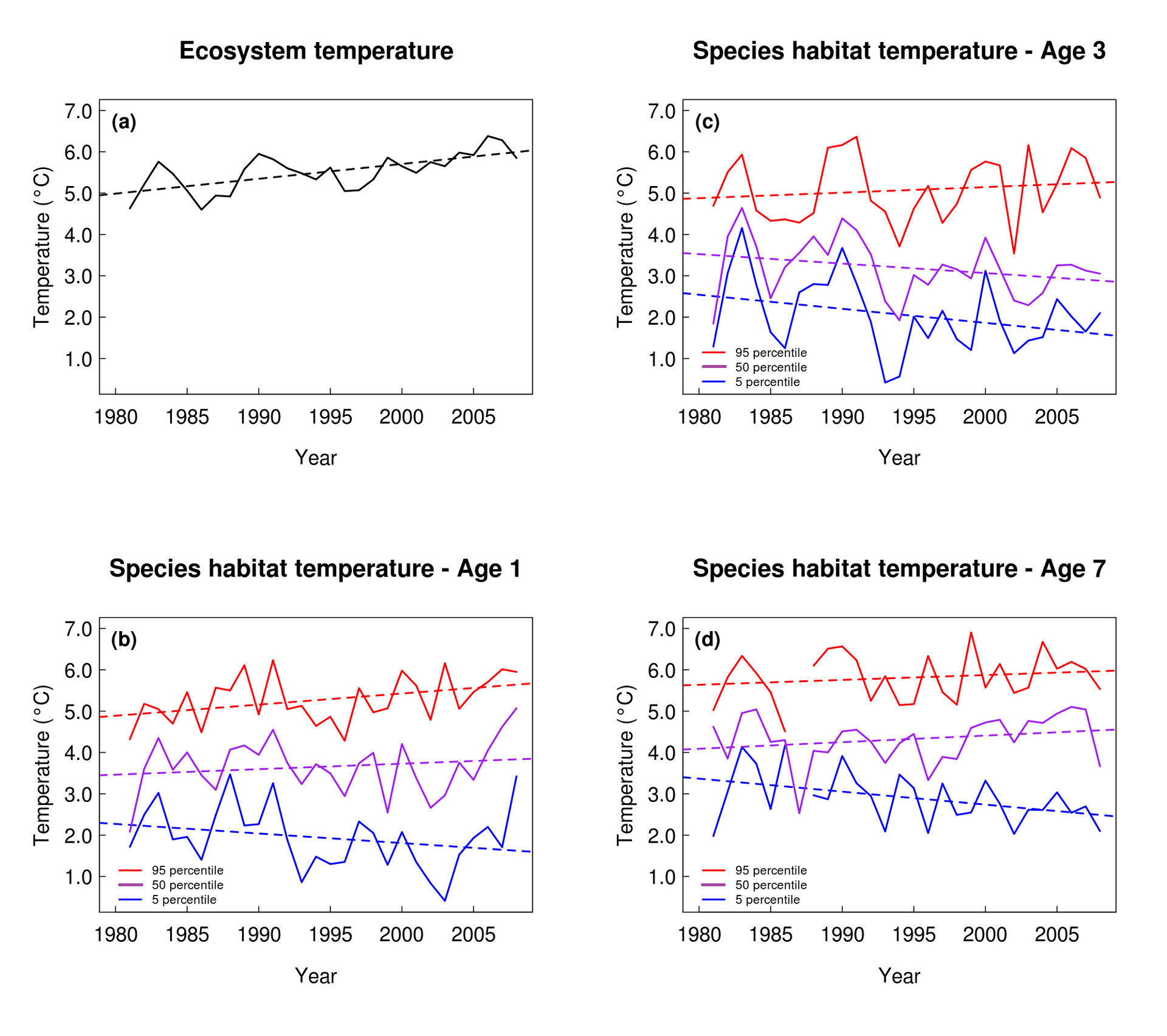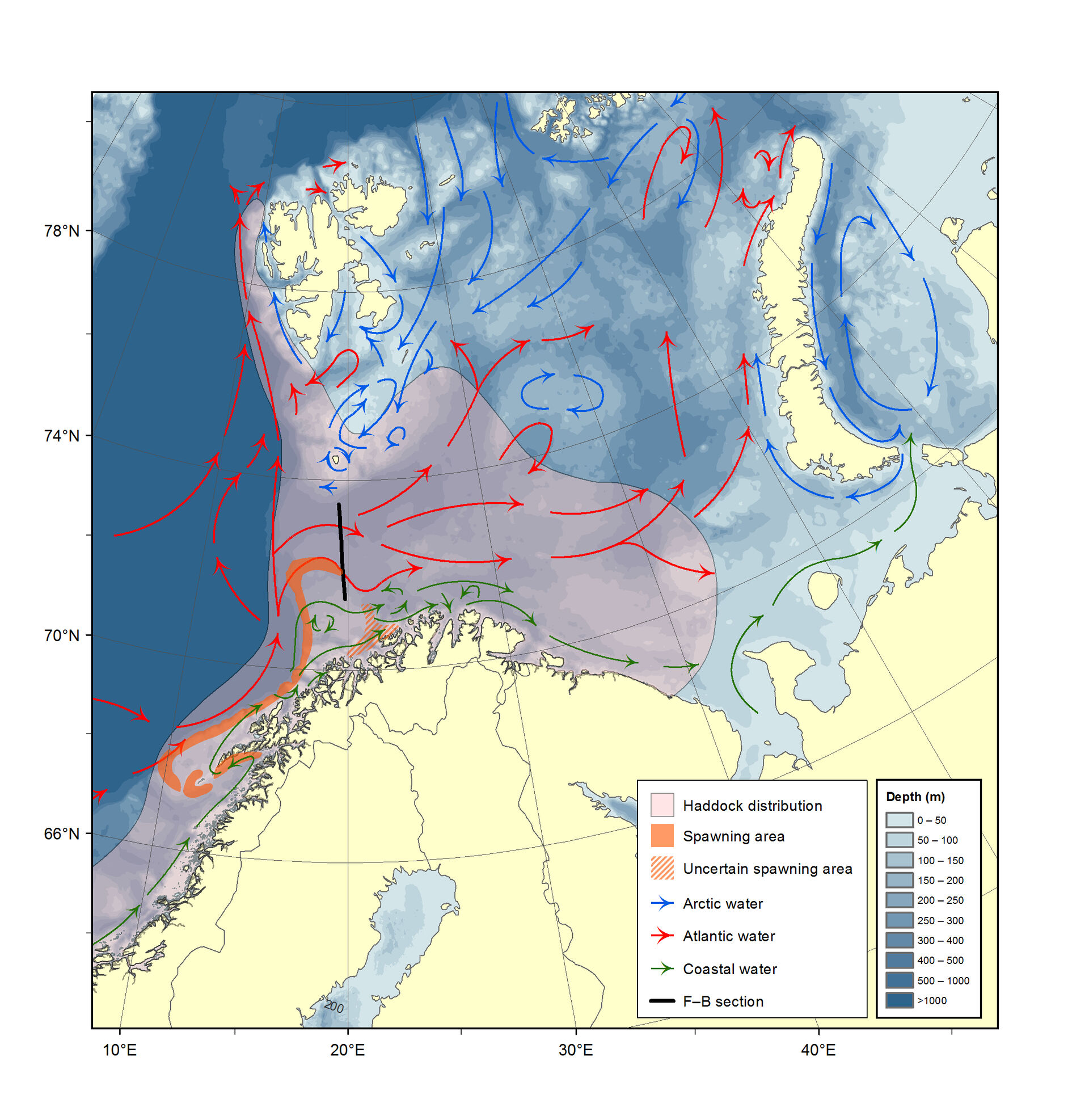In the Barents Sea the cod (Gadus morhua) and haddock (Melanogrammus aeglefinus) stocks are near the northern temperature boundary of their species’ overall habitat range and are thus expected to be particularly responsive to temperature changes. In recent, relatively warm years, the spatial distribution of the Barents Sea stock of cod has extended further north (to 82° 30N) and east (to 79° 30E) than ever observed before.
In a recent paper in Fisheries Oceanography Landa et al. (2014) examine the connections between sea temperatures and abundance and distribution boundaries of haddock in the Barents Sea between 1981 and 2008. Relative to the cod, the Barents Sea haddock stock is far less studied, even if haddock also is one of the most abundant and commercially important species in the region. The study by Landa et al. (2014) is based on swept area densities of haddock from bottom trawl catches collected annually during the Institute of Marine Research’s winter surveys in the Barents Sea, spatial temperature data from the same surveys, as well as temperatures measured along a fixed oceanographic transect (the “ecosystem temperature” representing the indirect temperature effect on the haddock mainly through predators and prey). The effect of ecosystem temperature on haddock abundance and distribution boundaries were investigated, also taking into account possible density-dependent effects on distribution. They found a positive relationship between ecosystem temperature and abundance. Distribution boundaries are, on a year-to-year basis, more related to abundance than ecosystem temperature. The long term trends, however, indicate a north-eastward shift in distribution boundaries, probably related to the coinciding ecosystem temperature increase.
The ecosystem temperature is compared with the “species habitat temperature” of haddock. The latter is the fish-density weighted ambient temperature per age group in the population and year and represents the direct temperature impacts on the fish (growth, physiology..). It is shown that the two different temperature measures develop differently throughout time. This has earlier been shown for BS cod and seems to be a particular trend for populations in the Barents Sea, where a strong permanent southwest to northeast temperature gradient is present. For haddock the species habitat temperature showed larger inter-annual variability than the ecosystem temperature. This is not really surprising, but is a consequence of the very nature of the former. As the species habitat temperature depends on both the ecosystem temperature and movements by the fish, an additional source of variability is added. While the ecosystem temperature displayed a gradual increase throughout the study period, such a trend in the median species habitat temperature was only seen for older fish. Thus, even if the overall temperature in the Barents Sea increased the temperature perceived by the “typical” haddock did not. This can be explained by 4- to 7- year old haddock expanding towards the north and east into colder waters, likely because of increased food availability, but density dependent mechanisms may also be at play (think of ideal free distribution, density-dependent habitat selection).

Figure 2. Development of the ecosystem temperature (a) and species habitat temperature for 1- 3- and 7-year-old haddock (b–d) between 1981 and 2008. The ecosystem temperature is shown as a solid black line, with the linear trend as a dotted black line. Blue, purple and red solid lines are the 5, 50 and 95 percentiles of the species habitat temperature, whereas dotted lines show corresponding linear trends.
A combination of continued increasing abundance of NEA haddock and increasing ecosystem temperature are likely to result in further north-eastwards distribution shifts. However, a major difference in the poleward shift of fish species must be emphasized. While pelagic species such as
mackerel, blue whiting, herring and capelin have the potential to take benefit from a potential increased zooplankton production in the polar basin under future climate change, the habitats of the demersal fish species are constrained by the continental shelves and they will, consequently, not be able to expand their habitat poleward beyond the shelf break. A further migration of demersal species like haddock or cod is, thus, limited to an eastward expansion along the Siberian shelf.
Landa, C.S., Ottersen,G., Sundby, S., Dingsør, G.E., & Stiansen, J.E. (2014). Recruitment, distribution boundary and habitat temperature of an arcto-boreal gadoid in a climatically changing environment: a case study on Northeast Arctic haddock (Melanogrammus aeglefinus) Fisheries Oceanography, 23 (6), 506-520 : 10.1111/fog.12085

Log in to comment
Not UiO or Feide account?
Create a WebID account to comment